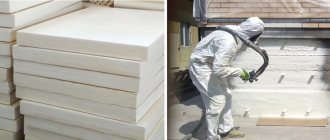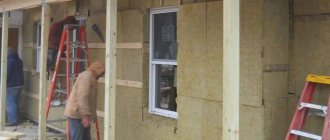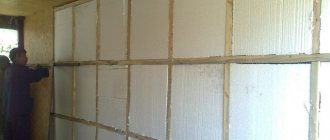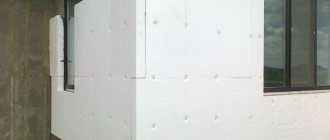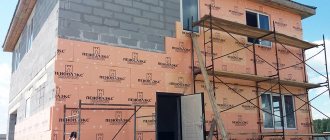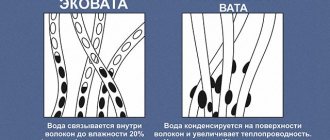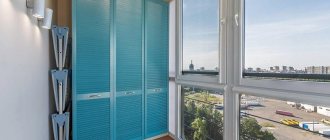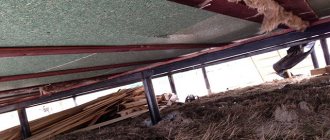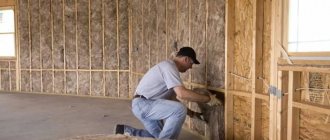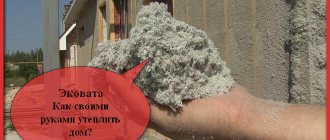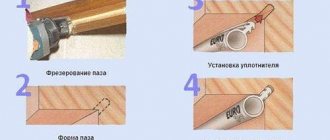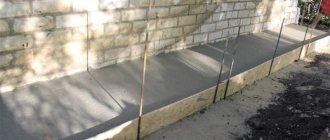In modern construction, metal structures are used quite often due to the combination of properties that are inaccessible to other materials: strength and reliability and, at the same time, low weight, and with proper use, durability of use is also added. Customers are pleased with the high speed of construction work and its low cost. But there is also a big drawback: insulation of metal structures is required, since metal has high thermal conductivity.
Insulating metal structures from the inside using sprayed polyurethane foam is one of the best options: high aggression with metal, low thermal conductivity.
How to insulate a metal frame with a cold attic, the columns go into the parapet
Insulation from the inside was considered, but there will be a collective farm option, especially since the area is seismic, it’s stupid to install gas blocks from the inside of the racks, we lose evenness and square meters
for 20 minutes. —— Yes, just metal sheets are welded for tightness, like tanks, only all straight
small boss in a large local office
1. We insulate everything outside. We do not heat the attic. The columns will be “warm” within the attic. 2. We insulate the columns inside the room, the ceiling is insulated. The columns are cold, but there will be no condensation, since they are inside the insulation.
insulation thickness based on dew point in special programs.
1. We insulate everything outside. We do not heat the attic. The columns will be “warm” within the attic. 2. We insulate the columns inside the room, the ceiling is insulated. The columns are cold, but there will be no condensation, since they are inside the insulation.
insulation thickness based on dew point in special programs.
in your case, you will have to insulate all the columns at the level of the attic, but do not forget that the parapet fiber-reinforced concrete (decorative element) is attached to these columns by means of horizontal beams with a pitch of 500mm, if they are also insulated, it will not really be much
1. We insulate everything outside. We do not heat the attic. The columns will be “warm” within the attic. 2. We insulate the columns inside the room, the ceiling is insulated. The columns are cold, but there will be no condensation, since they are inside the insulation.
insulation thickness based on dew point in special programs.
this will have to insulate all the beams inside since they are rigidly welded to the columns, it is expensive and inconvenient to insulate the beams on top, as far as I understand, the main thermal insulation will be attached there to already wooden beams
4 min. —— Colleagues, is there a simple and durable solution, like our grandfathers did?
Source
diverse possibilities of modular houses
Metal modules are most often chosen for areas with aggressive climates. Wind gusts and precipitation cannot be compensated by the standard construction of an ordinary house. A base made of strong and durable metal protects the interior of the house from possible negative factors, creating a feeling of privacy and security.
In order not to lose touch with the natural environment, the architects made an attractive maneuver by using continuous glazing of the front façade on the north side. The back side is lined with wooden boards. The color scheme of the finishing materials looks harmonious, because the wooden beams have an unnatural greenish tint. Thus, the exterior merges with the landscape, masquerading as the beauty of the surrounding area.
In conditions of strict modulation, the owners of such a shelter do not have many layout options. The corner section houses the bedroom and bathroom, while the central section is reserved for a small kitchen and living room. Thanks to the compact distribution of living space and choice of furniture, residents can move freely around the room.
An additional advantage is the presence of a balcony with wooden flooring. The minimalist design style is maintained inside and outside the building. The black and brown color scheme of the interior smoothly transitions into the exterior in the form of metal railings and natural wood texture. The straight lines of the structure become an allegory to the natural environment, complementing its curved forms and constant intertwining of plants, trees, and hills.
The fact remains indisputable that a metal modular house is a modern, practical, rational solution for organizing living space. Designers are only increasing the popularity of such housing by presenting different interpretations of interior and exterior design.
| Architects | Bruno Zaitter arquiteto |
| Photo | Sergio Mendonça Jr. |
Looking for energy efficient solutions?
Pay attention to FORUMHOUSE geothermal heat pumps
Ground source heat pump EU (start/stop)
Geothermal heat pump IQ (pseudo-inverter)
IQ ground source heat pump (inverter)
Based on real events! Construction of a workshop in -20 degrees Celsius. Perhaps these two sentences best describe the experience of a FORUMHOUSE user with the nickname VMG. Background - a portal member builds custom boats. The owner of the premises raised the rent for the workshop three times in winter. VMG had to make room and, with all the tools, go to their site. But we need to work. Time is running out. A standard cabin will not do. It will not fit oversized parts. Exit? Quickly build an inexpensive workshop measuring 7000x3800 mm. Let's tell you how VMG succeeded.
- Which foundation to choose for a workshop
- How to build a workshop on a metal frame
- How to make a floor in a workshop
- How to bring materials to the site
- How to cover the walls of a workshop
- How to insulate a workshop
- How to heat a workshop in winter
- How much did it cost to build a workshop from metal pipes and corrugated sheets?
Development of a metal frame house project
Typical projects based on LSTC technology have been standardized; all that remains is to choose the best option with the required climatic characteristics.
An individual house project is carried out by the manufacturer
. The first stage will be the creation of technical specifications for the project. The technical specifications determine the desired size of the building in the axes, number of storeys, layout features, main and finishing materials of the building.
In places where wall-mounted furniture and hanging cabinets are attached, reinforcement of the wall rigidity with additional profiles is provided in advance.
On average, calculation of a private house project takes 2-5 working days
. Miscalculations, errors, disproportionality, inconsistency of parts must be eliminated in a factory manner. Sometimes on forums the characteristic clicking sound of the frame when heated is discussed.
note
Profile cracking in the sun is possible only due to errors in installation, trimming of the profile, or installation of additional holes.
Properly mounted, unmodified profiles do not produce sounds.
Pile-screw foundation for a workshop
So, VMG began construction of the workshop in the winter. The task is to quickly put up the “box”. How to do this if:
- It's frosty outside
- Time is short
- Concreting is no longer necessary
The solution is to put the workshop on “all-weather” screw piles.
I bought four piles. They turned it themselves. I used a jackhammer to remove the frozen soil to a depth of 0.3 - 0.4 m. Next came ordinary soil. The piles were screwed in without any problems. It turned out that one side of the workshop stands on stilts, and the other side rests on a concrete platform - the base of the canopy in front of the house.
Site selection
An important stage of construction is the selection of a specific plot of land. The following requirements apply to it:
— If there is no pipeline, it is necessary to take into account that you will have to dig a well or drill a well. Therefore, there must be drinking water on the site. At the same time, its source should not be located at a depth of more than 50 meters, since in this case expensive work will have to be carried out. - Maximum flatness of the surface, which will create additional convenience for building a house and reduce the cost of its foundation. - Location on a flood-free area. Areas located near rivers or other bodies of water will certainly flood in the spring. Sometimes this problem also exists in lowlands. Water that remains on the site for only 2-3 days washes away the foundation. This is not very good for the house. - Minimum number of buildings already erected. If a plot of land is purchased with a wooden house that is intended for demolition, then it is desirable that the building stand on a brick foundation. In this case, preparation for work will be less expensive.
Workshop frame made of metal profiles
When building a workshop, everyone chooses a material and technology familiar to them. For some it is a wooden frame. For others - gas or foam concrete. VMG works with metal, so he chose a metal profile.
I welded the base for the workshop from scraps of the 12th channel. Logs made of profile pipe with a cross section of 10x5 cm, wall thickness 3 mm. I also had to buy a profile pipe 50x50x2 mm. The profile was welded on the base of the “platform”. It was -20°C outside. The pipes are covered with snow and ice. Therefore, it was not possible to paint them. I think it’s not a problem, there will be enough for my lifetime and there will be some left for my children.
Source
House frame
The metal profiles used to assemble the frame undergo special treatment in factories using hot-dip galvanizing and are coated with anti-corrosion enamels or mixtures. For the construction of cottages, thin-walled or standard metal profiles are used. All structural elements are excellent for internal and external cladding and installation of windows, doors and partitions.
To work with metal structures, you do not need special knowledge or extensive experience. All parts and holes are made with extreme precision. Structural elements arrive at the construction site with special markings applied at the factory, which greatly facilitates their installation.
The assembly of the house frame is carried out using the so-called screwdriver technology. This became possible thanks to the use of a new method of manufacturing parts at the factory. You won't need to measure anything or cut off unnecessary lengths. All elements are strictly calculated and manufactured according to your home design. Each detail has its own place and purpose.
Is it necessary to insulate a metal garage?
A structure made of a metal profile and thin-sheet galvanized steel has the property of quickly heating up and releasing heat to the environment. Therefore, in hot weather it is stuffy to be in the garage, and in winter the car freezes. As a result, transport servicing is accompanied by significant discomfort.
When temperatures change inside the structure and on the surface of the car, condensation forms. Moisture has a destructive effect on the anti-corrosion coating. This fact leads to the appearance of rust on the metal.
Metal walls without anti-corrosion protection in damp rooms quickly rust
The extremely low temperature according to SNiP 02/21/99 is considered to be +5 degrees Celsius. This condition can only be ensured by thermal insulation of the walls and ceiling of the garage. The event will also help prevent overheating indoors in the summer.
Traditional approach
In cases where it is undesirable to overload the facade due to the small safety margin of the house, it is necessary to dismantle the outer part to add insulation.
Disassembly
Careful actions during disassembly will help avoid additional costs:
- First, the exterior trim is removed;
- The base is dismantled;
- The counter-lattice is disassembled;
- The wind protection is removed.
- After adding the insulating layer, the restoration of the facade occurs in the reverse order.
Adding insulation
When access to the frame racks is free, a visual inspection of the frame filled with insulation is carried out. If construction defects or negative changes have been detected over the past period of operation, measures must be taken to restore the integrity of the insulation.
Perhaps these will be separate, not very significant, cracks in the junctions of the insulation and studs, or an increased gap between the insulation boards due to shrinkage - they must be carefully treated with polyurethane foam.
After this, beams equal in thickness to the insulation are sewn to the frame racks. As a rule, this is a 50 X 50 beam, for using basalt slabs of the same thickness. The technology is similar to the initial structure of the frame, the main thing in which is the absence of cracks and gaps. The façade is then restored to its pre-disassembly state.
If the facade was dismantled carefully and accurately, then some of the materials can be installed back. But practice shows that it is better to use new materials to restore the facade, and use the removed ones in less critical structures.
Methods for insulating a metal garage
You can insulate a metal garage inside or outside. If the structure is an autonomous building, then the priority option would be to carry out work on the facade side. Often the premises are located inside the complex. In this case, the insulating materials will have to be placed indoors, on the inside.
Insulation of a metal garage from the outside
For external insulation, materials are selected in accordance with the selected finish. If plastering is involved, then it is better to stick to hard slabs. These include expanded polystyrene. Mineral wool and polyurethane foam can also be used under cladding or brickwork made from frost-resistant materials.
As an alternative, manufacturers offer ready-made decorative sheets with insulation. These include rigid slabs to which corrugated sheeting, clinker tiles or plastic panels are glued. They can be installed using a special solution, polyurethane foam or lathing.
Insulation from the outside is completed by painting
Less commonly, brick is used to insulate a metal garage. On its own, this finishing material copes with maintaining heat inside in conditions down to -15 degrees Celsius without wind. In other cases, additional thermal insulation is fixed between the masonry and the metal base and an air gap is created.
Insulation of a metal garage from the inside
The interior space of the garage is often used as a workshop, a place to store tools and things. That is, shelving, a workplace, and tanks can be located around the perimeter. This helps to reduce the area for placing a car.
Insulation of metal walls, protection of thermal insulation sheets, and decorative finishing lead to a reduction in the garage area. Therefore, when choosing materials, their thickness is taken into account. Thin-layer options are polyurethane foam and extruded polystyrene foam.
Use of polyurethane foam
Modern scheme for insulating metal structures.
Sprayed thermal insulation meets all the requirements of an ideal insulation; it is an invention of the 21st century. Polyurethane foam is extremely durable, which allows you to apply insulation not only from the inside, but also from the outside. The increase in volume after spraying makes it possible to close internal cracks, and resistance to the penetration of foreign substances will protect the structure frame from most external factors. The high speed of application is also important; it reduces the time required to complete the work.
A special installation is used to work with polyurethane foam. Its task is to mix two components (polyurethane foam components) in the required proportion. Workers are protected by special clothing and a respirator. Therefore, only specialists can perform this task.
The prepared surface is coated by spraying a layer of substance. The process itself is simple, it resembles painting a structure with a spray gun, only instead of paint, a substance gets onto the surface and turns into foam. The main task is to make the layer as uniform as possible and cover the entire surface.
A few minutes after application, the polyurethane foam foams and hardens. After this, the next layer can be applied and so on until the required thickness is achieved. The insulated surface does not require additional coating. After the foam has hardened, it is ready and suitable for use.
What features should insulation have and why?
All materials that can be used for thermal protection must meet the following requirements:
- Have a low thermal conductivity coefficient;
- Possess good fire safety performance;
- Have low water absorption;
- Have no shrinkage or shrink as low as possible;
- Have good environmental friendliness.
- Let's look at why these properties are needed in more detail.
Thermal conductivity
This indicator is responsible for the ability of insulation to transfer heat. The lower this coefficient, the less heat the material transmits. This means that in winter the insulation prevents the building from quickly cooling down and, accordingly, from warming up in summer.
Advice! Based on this indicator when choosing, the user must take into account the thermal conductivity coefficient when used in specific climatic conditions.
Fire safety
This indicator is responsible for the ability of insulation to withstand high temperatures without losing its functions, without deforming, without changing its structure. Insulation of frame houses with mineral wool is considered reasonable and correct because this indicator is regulated by GOST standards. Mineral wool has them and fully meets them.
Water absorption
The next important parameter after the previous one is responsible for the ability of the material to absorb moisture and retain it. If the material absorbs water strongly, it releases heat faster and stronger. This happens because the pores in the insulation are clogged with water, and, according to the laws of physics, it has greater thermal conductivity than air.
And then, if the moisture absorption is too high, the material, at too low a temperature, can simply freeze, and when it turns into ice, it can completely lose its properties.
Therefore, the smaller its parameters, the better the material.
Shrinkage
When choosing to insulate a frame house with high-quality mineral wool, you should also pay attention to this parameter. This coefficient should be as small as possible. Otherwise, over time, after shrinkage, subsidence will begin to appear in the places where the heat insulation is laid. This means that cold bridges will definitely appear there, and this is very bad. A cold bridge is an ideal area for removing heat from inside a room.
Environmental friendliness
The basis of thermal protection is insulation, which is located along the entire perimeter of the building. It is very important that it does not emit harmful radiation and fumes in the form of compounds and substances hazardous to health.
optimal location and linear configuration of metal frame construction
The facility is located away from the noise of the city and highways. The nearest neighbors and the country road are hundreds of meters away - the windows offer views of natural landscapes in any direction. The architects chose to make the metal frame house as open as possible, without hiding the landscapes behind the fence. In one direction there is a panorama of the lake, in the other - of the garden.
At the same time, the site is localized from views from nearby areas with the help of green spaces - trees, shrubs. And modern security systems make it protected even in open conditions.
The linear configuration provides direct access to the local area from any room in the building. There is a close connection between the external and internal space, a smooth transition between them.
Types of insulation
The process of insulating a garage depends on the selected thermal insulation material. In some cases, installation involves additional costs for lathing and finishing; in some cases, insulation is simply applied to the walls. Since the garage is made of iron, it heats up in the sun and collects condensation well. Therefore, materials should be chosen that are most moisture resistant.
For example, mineral wool is not suitable in this case. It will begin to rot, and the insulation will have to be replaced pretty soon.
The following materials are ideal as insulation for an iron garage:
- extruded polystyrene foam boards, polystyrene foam or penoizol;
- polyurethane foam;
- heat-insulating paint (for example, “Astratek”).
Polystyrene foam is durable, resistant to moisture, it is cheap to insulate, but it is highly flammable. Penoplex is a variety of it. It is twice as expensive, but the slabs are thinner if the thickness of the walls is important, and also does not require additional waterproofing. You can even insulate the floor with penoplex slabs by making a concrete screed directly on it.
Penoizol is essentially the same penoplex, only in a cylinder. It is twice as expensive and requires special equipment. It is applied to walls in the form of foam, like polyurethane foam. Polyurethane foam (PPU) is more expensive, but there are no seams. Environmentally safe, non-flammable.
Disadvantages include the need for equipment to spray foam and vulnerability to sunlight.
Thermal insulation paints do not require additional wall finishing, since they are also a finishing coating. They are frost-resistant, not afraid of moisture, and can be applied quickly. A 1 mm layer of paint can replace 5 cm of mineral wool. To create the necessary thermal insulation, it is enough to apply two layers. This material is very expensive, but it does not take up useful internal space.
Not only the walls and ceiling, but also the floor should be insulated. It is through it that 20% of the heat escapes.
The insulation of iron garages itself is carried out exclusively from the inside.
Penoplex and foam plastic
Before insulation, the surface must be prepared. Remove peeling paint and clean off rust. It is recommended to paint the walls and ceiling to protect them from corrosion. The color and choice of paint is not important; it will still not be visible under the trim. Therefore, you can save money and buy something inexpensive. If the garage is made of galvanized profile, then nothing needs to be done.
If the region has frosty winters, then the thickness of the foam plastic should be at least 10 cm, penoplex - 6-7 cm. A thinner layer will not provide the required thermal insulation. The material is glued to the walls and ceiling with construction adhesive, for example, liquid nails. Can also be glued to polyurethane foam. It will expand within an hour, so the slabs should be periodically pressed against the walls. All cracks are sealed with polyurethane foam. To increase the thermal insulation properties, foil can be glued to the slabs.
If you get two layers of polystyrene foam, then one of them can be replaced with double-sided foil-coated isolon.
Next you need to make the sheathing. You can use an existing metal garage frame as a frame. The lathing is made of wood in increments of 25–30 cm. You can use a galvanized profile, but then it will be more expensive. Under no circumstances should the insulation protrude beyond the sheathing. As finishing, you can use clapboard, plywood, moisture-resistant plasterboard, OSB panels or plastic siding. Gates and doors are insulated in the same way as walls.
Polyurethane foam
The surface of the garage walls must also be prepared, special attention to oil stains - there should not be any. The air temperature in the garage should be at least 10 degrees Celsius. Both the walls and the ceiling are insulated. Polyurethane foam is sprayed using special equipment under pressure, somewhat reminiscent of the painting process. The components are mixed and at the output they give the very reaction due to which foam is formed. The material hardens very quickly. The difference between polyurethane foam and penoplex is that it gives additional rigidity to the structure; no glue is required. The thickness of the formed foam should be 3–4 cm. For comparison, this replaces 5 cm of mineral wool.
Another advantage of polyurethane foam is that it does not require lathing. The top can be covered with paint or plaster. The high cost of polyurethane foam is compensated by savings on glue, lathing and facing material, not to mention the thickness of the walls and the load of the structure.
It is impossible to leave polyurethane foam without lining, since the sun's rays have a destructive effect on it.
“Astratek” paints
“Astarek” paint is a mastic that can be applied with a brush or spray. After drying, an elastic coating is formed. The paint simultaneously acts as insulation, is used for waterproofing, and has anti-corrosion properties.
Basic properties of light steel thin-walled structures
- Light houses on a metal frame do not exert excessive pressure on the soil, without creating shrinkage. Thus, their design is not subject to deformation. This allows you to keep the exterior and interior decoration intact;
- Houses on metal frames are practically not susceptible to rotting. The metal does not allow putrefactive bacteria to develop;
- They have increased wear resistance. They can be used for a long time, and the materials from which they are made will not change their characteristics;
- This technology allows you to create a large number of different design options;
- The ability to quickly implement architectural ideas;
- Frames of this type are absolutely compatible with other materials;
- The structures have increased fire resistance. This advantage is considered one of the most basic. It is assumed that mainly non-combustible materials are used in such a building.
How to make a metal frame yourself?
If you need to assemble factory parts into one design, this can be easily done with help. The difficulty lies in finding the required element and installing it according to the drawings.
If it is necessary to weld frames from a profile pipe, then this is a rather complicated matter. Although for the construction of a small country house, the frame is installed similarly to a wooden one. For a one-story building, pipes of 80*80 mm are suitable; for intermediate elements, a smaller diameter is suitable. But it also needs to be insulated.
ATTENTION! For reliability, it is best to purchase a disassembled house structure from the manufacturer.
Simple, inexpensive, reliable
Since money has already been invested in the facade and its insulation, the desire to make an additional layer inexpensively and with maximum return is fully justified. The most affordable insulation material is glass mineral wool. If you deviate slightly from the standard installation of glass wool between the laths, then the economical step-by-step technology looks like this:
- A vapor barrier is stapled to the existing façade. We proceed from the fact that since the room is cold, heat loss could occur due to a violation of the vapor barrier - therefore we perform the full insulation cycle almost all over again;
- Instead of wooden frame bars for installing glass wool, you will need: a metal framing profile; mounting angles for profiles, hangers, disc dowels;
- A profile selected according to the thickness of the insulation, usually 50 mm, is attached to metal corners along the perimeter of the surface to be coated;
- Suspensions, usually 4 pcs. on the insulation board, attached to the facade;
- A slab of glass wool is inserted into the groove of the profile and then cut through with hangers and fixed to them;
- A disc-shaped dowel is driven into the center of each slab for final fixation of the wool;
- Next, close to the surface, subsequent insulation boards are secured in a similar manner;
- Then the insulated facade is covered with a windproof film, which is attached with four disc-shaped dowels through the film on each slab to the surface of the facade;
- After completing the installation of the windbreak, profile posts are attached to the surface for installing siding cladding.
Additional insulation of a frame house with glass mineral wool can be done from the outside using OSB, moisture-resistant plywood, lining and other materials.
The surface of the facade must first be cleaned and leveled
Description of the insulation process
When insulating different types of enclosing surfaces of a frame house with mineral wool, their own insulation scheme is used. But just like for frame walls, one general rule applies - the vapor barrier of the insulation is carried out from the side of the heated room.
The vapor barrier is laid in a continuous layer without “gaps” between the insulated surfaces
Floor slab above basement
In the case when the frame house project includes a basement, a strip foundation is used as the foundation.
The standard scheme for insulating the concrete floor of the first floor with mineral wool for laying floor tiles is as follows:
- Level the surface of the slab using a screed.
- Lay a waterproofing layer.
- Rigid slabs of mineral wool (density from 150 kg/m3) are laid.
- Cover the insulation with a continuous layer of vapor barrier film.
- A cement-sand screed is poured as a subfloor.
- Install the floor covering.
Note : To lay parquet, sheets of moisture-resistant plywood are additionally attached over the screed.
Insulated concrete floors on the ground have a similar structure.
Scheme of insulation of a concrete floor on the ground
When installing a wooden subfloor, the insulation scheme looks like this:
- Overlap.
- Waterproofing.
- Lags.
- Mineral wool between joists.
- Vapor barrier.
- Boards or plywood as a base for the finishing coating.
Wooden floor of the first floor
The traditional wooden floor plan looks like this:
- Load-bearing floor beams resting on the foundation (beam of the bottom frame on the grillage or plinth of the strip base).
- Additional logs and crossbars, which are installed taking into account the area of the room and the thickness of the subfloor boards.
- Skull bars fixed at the bottom of beams, joists and cross members.
- Board sheathing to support the waterproofing of the insulation.
- Waterproofing membrane.
- Mineral wool laid between the ceiling elements.
- Vapor barrier.
- Rough floor.
If the height of the subfloor allows you to install the lining from below, then you can do without a cranial block
. Note. There are other insulation schemes. For example, they use a mesh that allows you to fully use the entire volume of the ceiling for insulation. Or installing an additional counter-lattice and another layer of floor insulation for frame houses in regions with cold winters.
Insulation of the facade of a frame house
External insulation of the walls of a frame house with mineral wool is usually carried out according to the ventilated facade scheme:
- Install the sheathing for laying the insulation. The height of the cross-section of the beam must correspond to the thickness of the mineral wool; the layout step is chosen 5 cm less than its width.
- Mineral wool mats are laid and fixed to the sheathing.
- A layer of waterproofing windproof membrane is attached.
- Install the counter-lattice. The height of the bar must be at least 6 cm (SNiP requirements for the size of the ventilated gap).
- The walls are covered with façade panels.
One of the options for a double layer of thermal insulation - internal (between the racks) and external (along the sheathing)
Insulating a cold attic
In this case, it is not the roof that is insulated, but the wooden floor. And the vapor barrier is laid in such a way as to protect not only the mineral wool, but also the wooden beams from getting wet. The classic scheme looks like this:
- A suspended ceiling is mounted along the floor beams, to which a vapor barrier is attached underneath in a continuous layer. These can be either anti-condensation or reflective vapor-proof materials.
- Mineral wool is laid between the beams, on the attic side, on the false ceiling.
- A waterproofing membrane is attached to the beams.
Note. According to the standards, waterproofing of the insulation of a cold attic is recommended only along the perimeter with a width of at least 1 m.
- If the thickness of the insulation occupies the entire “internal” volume of the floor, then spacer slats are mounted on top of the beams to create a ventilated gap.
- The floor is mounted on beams (or spacer slats).
Roof insulation
Thermal insulation of the roof can take place according to two main schemes:
- With one ventilated gap between the waterproofing and the roof. A superdiffusion membrane is used, which is laid directly on top of the insulation.
- With two ventilated gaps. The first is between the insulation and the waterproofing film, the second is between the film and the roof. It is used for metal roofing when waterproofing materials with limited vapor permeability are used.
Standard layout of an insulated roof with a waterproofing membrane and one ventilated gap.
The structure of the insulated roof from the attic (attic) side looks like this:
- Internal lining secured to sheathing.
- Vapor barrier.
- Insulation placed between the rafter legs.
- Waterproofing fixed to the rafters (one ventilated gap) or to the spacer batten (two ventilated gaps).
- Lathing for roof installation.
negative nuances of a metal frame house
When covering the surfaces of a frame house, it is necessary to use heat and sound insulation. You should also not forget about the “cold bridges” that metal elements act as. To ensure that in cold climates the rooms are not only spacious and bright, but also warm, it is necessary to provide additional insulation for metal elements.
Metal structures require a special approach to interior design. With a skillful approach to the design of rooms, beams, crossbars and metal racks will give the rooms restraint and nobility. Bright color elements and pastel colors of finishing materials will help soften industrial shades.
| Architects | Marcos Franchini, Nattalia Bom Conselho |
| Photo | Jomar Bragança |
Garage Doors
Insulating a metal garage also means insulating the garage door.
Curtain device
It is recommended to make a small door in one of the garage doors, and attach a curtain made of thick fabric or polyethylene film with a thickness of at least 0.8 mm to the upper edge of the door, designed to retain some of the heat in the room. But it is better to use transparent plastic for this purpose, which provides sufficient visibility when leaving the garage.
The selected material should be cut into strips of such length that, when fixed above the gate, they are at a distance of 1 cm from the floor level.
The width of the strips can vary from 20 to 30 cm. The strips should be stapled to a wooden batten so that an overlap of 1.5-2 cm is formed between them.
Under the influence of gravity, the strips will hang evenly, and after a forced deviation, they will return to their original place.
rationality of metal modular houses
One of the main characteristics of the modular design of a residential building can be called rationality. Clearly constructed lines and the compact shape of the premises allow, even with limited space, to arrange the necessary zones. On a metal base 3.6x3.6x2.5 meters, a sleeping place, kitchen and bathroom are comfortably organized. For a young couple, this space is enough to create a cozy place.
In the photo we see a project consisting of 3 separate modules, which are located in the middle of a rural settlement. A mini-shelter, despite the small living space, the metal modular house forms a modern shelter. Thanks to its unique location among steppe meadows, the panoramic glazing of the central part offers an impeccable landscape.
Technologies for insulating walls of frame houses from the inside
Diagram of the construction of frame walls and their thermal insulation
Firstly, for this you need to stock up on the following materials:
- glassine (to create a waterproofing layer);
- beams or metal profiles (for assembling the frame);
- vapor barrier (for example, penofol);
- insulation (let's take mineral wool as an example);
- edged board with a section of 2.5x15 cm and a humidity of no more than 15%.
Secondly, before moving directly to the thermal insulation of the walls, prepare them in this way:
- remove dirt and dust using a broom and vacuum cleaner;
- remove protruding nails (if any);
- dry the walls thoroughly (you can use heaters for this purpose);
- Fill all the cracks with foam.
So, the technology of wall insulation:
- Waterproofing. For this, as mentioned above, we use glassine. It is cut into separate strips according to the dimensions of the walls and attached using a construction stapler.
Important! Glassine strips are laid with an overlap of 10 cm and secured along the joint in increments of 10-12 cm.
A layer of glassine will provide good waterproofing, due to which moisture will be removed from the insulation to the outside of the frame house, which in turn will dry naturally.
- Frame assembly. It is made either from beams or from metal profiles (read how to properly construct a frame in our other articles). In principle, everything is visible and clear in the figure.
Wooden frame with insulation already laid
Metal frame using the example of garage insulation
- Insulation of a metal or wooden frame. At this stage, the insulating material is laid. In our example, this is mineral wool. It is cut to the required size using a knife and placed between the frame posts.
Note! When cutting mineral wool, add 5 cm on each side. This is done so that the material lies as tightly as possible, without the formation of gaps between the pieces of insulation.
Do not throw away the remaining mineral wool scraps, but use them as strands laid between the joints of the insulation.
- Vapor barrier. A vapor barrier such as penofol 3 mm thick is well suited for mineral wool. It is laid on walls in the same way as glassine. That is, first we cut the penofol into strips with an allowance of 5 cm, and then we overlap and secure with a stapler.
- Covering the walls and thermal insulation layer with edged boards using standard technology.
This, in principle, is the whole scheme for insulating a frame house, or rather its walls.
Advantages and disadvantages
Any private house based on a metal frame has the following undeniable advantages:
- the total weight of the mounted structures is much less than that of a brick or log building of the same area and volume. A lower load allows for a cheaper foundation;
- the house is actually manufactured in a factory where metal elements are cut to the required length. At the site you just need to assemble it according to the instructions. Two to four people can handle this;
- speed of construction. In a few weeks, you can not only assemble the frame, but also form a wall pie, cover the roof and sheathe the outside of the walls.
Construction using LSTK frame technology has one significant drawback - this is the requirement for private developers to strictly comply with all construction algorithms.
Also, metal frames need a large number of stiffeners to withstand the same wind loads.
The wall metal profile fully meets the requirements of SNiP from a safety point of view. However, many believe that houses with an entirely wooden frame are more environmentally friendly, although a noticeable difference is observed only in sound insulation, since metal is more permeable to all kinds of vibrations.
Simple foundation of a frame house
Floor insulation
Insulation of floors in a frame house, as well as insulation of walls, is a mandatory procedure. Otherwise, all the heat will go into the basement of the house. Insulation allows you to avoid heat loss and cold air entering the room from the ground.
The sequence of work is approximately the same as when insulating walls. You will have to act depending on how the floor in the house is arranged. Usually these are logs that rest directly on the foundation or special support pillars.
And here you can see perfectly installed logs of the future floor
Note! Even at the stage of building a frame house, it is necessary to ensure that the logs are made with an interval of no more than 58 cm. Then it will be possible to simply lay mineral insulation of the required length. Too large a distance between the joists is inconvenient not only for subsequent thermal insulation, but also due to the fact that the finishing floor covering may begin to deform over time.
Floor insulation in a frame house begins with the construction of a subfloor, which is necessary for laying a heat insulator between the joists. It is made from a 10x2.5 cm edged board. The boards can be laid in various ways.
Here's one of the simplest:
- Screw 5x5 cm beams from below and across all the joists so that you create a division of the floor.
- Lay the edged board of the required length parallel to the joists, between them. Thus, the edges of the boards will rest on the foundation, and in the middle they will have support from the beams.
- Cover the subfloor with a waterproofing membrane to protect the insulation from moisture. The membrane is attached between the logs with an overlap on them using a construction stapler (step 20-25 cm).
- Next comes the installation of the heat insulator. For floors, it is better to buy rolled insulation, as it is convenient to roll it out to the desired length. It is laid in at least three layers (that is, the result should be about a 15-centimeter layer).
- The top of the insulation is covered with a vapor barrier membrane with an overlap of 10 cm. This way you will protect your work from water and steam that can penetrate from the room.
Vapor barrier membrane for floor
- The final stage will be laying the floors themselves. It all depends on your needs and capabilities.
Important! Do not forget that all wooden materials used in the thermal insulation process must be treated with antiseptics to protect them from rot and wood beetles.
List of metal disadvantages
Surprisingly, a metal frame is more dangerous during a fire than a wooden one. Using metal will not save your home from burning out, since the fire spreads from the outside of the building (in case of arson) or inside (in case of electronics failure) and in its path there will be many things and materials that burn well (furniture, finishing materials, various things).
In the event of a fire, it is vital that residents can quickly evacuate, and the more time they have before the building’s structures collapse, the better. The metal frame reduces the possible time for evacuation, because from exposure to direct fire and high temperatures it will begin to spiral, fall off and warp. But a wooden frame takes longer to deteriorate; the timber will become charred, but will retain its shape.
Another drawback that is discovered almost immediately when a frame house with an internal metal frame begins to be used is the difficulty of installing built-in furniture and appliances. The metal frame does not have a base on which you can attach the same shelf or install a cabinet. To solve this issue, it is necessary to determine in advance the places where reinforcement will be required using an additional profile.
It is also very important to ensure that the structure of a frame house made of metal profiles is protected from industrial current and atmospheric discharges. A metal profile is an excellent conductor of current, which can be dangerous for residents of the house
The problem can be solved by installing a potential equalization system, which should be calculated and installed by professionals.
Advice from professionals
You can reduce the thickness of polystyrene foam when insulating a garage internally using isolon. Polyethylene foam with foil coating is glued on top of thin sheet foam indoors. The disadvantage of such insulation is its relatively soft design. It is impossible to attach heavy shelves with objects to metal walls and ceilings. Therefore, this approach is relevant for a horizontal base.
The effectiveness of foam board insulation can be increased in two ways. Arrange thin sheets in a checkerboard pattern, foaming the joints. The second option is not limited to isolon. You can also carry out a combination with mineral wool. In this case, polystyrene foam acts as a water barrier.
If the building is autonomous, then it is better to insulate the facade. This way less condensation forms. In addition, the design of the ventilation gap promotes natural weathering of moisture. Inside a metal garage, forced ventilation will be required and the working area will be reduced; outside everything happens naturally.
Requirements for additional insulation
You should not insulate the house from the inside: this usually has an insignificant effect if the main insulating layer of the frame is made with errors or defects. In addition, internal insulation reduces the total usable area of the premises. For external insulation, three criteria can be taken as a basis:
The additional system of thermal insulation pie should not exceed the calculated load on the frame and foundation of the house: strengthening the foundation is a rather labor-intensive and expensive process;
The total thickness of the added insulation layer should be minimal and correspond to the size of the roof overhang. If you do not attach importance to this factor, then a decrease in the protective properties of the overhang from precipitation can lead to wasted spending on insulation. The insulating layer of the facade will be constantly exposed to rain and snow, which does not contribute to the effectiveness of the insulation. Altering the overhang will lead to unnecessary material and labor costs and may change the appearance of the house for the worse;
The demand for frame houses is largely due to the low cost of their construction and operation.
Therefore, when installing additional insulation, you should not use insulation materials that do not match the price of the structure: it is quite possible to find an inexpensive and effective option.
